Adventure Gamers - Forums
You are here: Home → Forum Home → Gaming → Adventure → Thread
Brian Moriarty’s The DIG
All right. Cards on the table.
Consider all the following texts on two levels: as applying both to the adventure games involved, and to real life.
That’s the proper spirit for an alternate reality game, after all.
Let’s call it Weavers against Chaos.
—
This is The Dig, an exciting space interactive adventure by film maker Steven Spielberg and game designer Brian Moriarty, to be published by LucasArts in the winter of 1993.
The Dig puts the player in the magnetic boots of Boston Low, commander of a team of space explorers stranded on a hostile planet millions of light-years from Earth. Sifting through the ruins of a lost civilization. Low must deal with the fear and treachery of his mutinous crew as he struggles to find a key to the alien technology that can return them all to Earth. A fabulous secret older than history awaits Low and his crew - but only if they can survive long enough to prove themselves worthy!
—LucasArts’ The Adventurer magazine, issue #6 (Spring 1993)
“A fabulous secret,” eh?
—
Development has been progressing rapidly over the last several months on The DIG, the deep space adventure being co-developed by LucasArts and film director Steven Spielberg. Designers Hal Barwood (Indiana Jones and the Fate of Atlantis) is lending his expertise to the games development team, along with director of development, Steve Dauterman. They are carrying out the production begun by Brian Moriarty.
—LucasArts’ The Adventurer magazine, issue #7 (Winter 1993/4)
Note the date… issue #7 of The Adventurer magazine came out precisely when issue #6 had claimed the game itself would be released.
Also mark the claim, in the official company newsletter, that Hal Barwood had stepped in as project leader once Moriarty left.
Yet this claim has been contradicted by numerous LucasArts employees who’ve spoken out since.
Consider this statement by Noah Falstein, in a 2004 interview:
Before talking about your version of The Dig I want you to help us solve this sort of puzzle issue. Exactly how many project leaders was? We know that you where the first one, Brian Moriarty was the second one. But then we have Dave Grossman and Hal Barwood. And Finally the last project leader was Sean Clark. (that give us five project leaders) Can you help us with this mess?
Hal Barwood was never a project leader for The Dig. The sequence was first me for about 18 months (Dave Grossman was a writer/designer/programmer on my version), then Brian Moriarty (I think also for a year or two - I served for a few months as producer on his version), Dave Grossman took over for a short while, just a few months I think, then Sean Clark for the last three years or so.
So, to reiterate a point, why would the official company newsletter get such a major fact so wrong?
—
Adventurer #7 in turn promised that The DIG would be released, under Barwood’s leadership, at the end of 1994.
But the Summer 1994 issue, Adventurer #8, suddenly announced that Sean Clark would take over the game, and release it the following year.
Again, note the date.
It’s a quite literate joke… a pun on Shakespeare.
His play Richard III opens by introducing the titular villain thusly:
“Now is the winter of our discontent / Made glorious summer by this sun of York.”
Let’s mangle that last word a little.
Suddenly, it’s Hamlet:
“Alas, poor Yorick! I knew him, Horatio.”
And then consider one of Hamlet’s other famous lines to Horatio:
“There are more things in heaven and earth, Horatio /
Than are dreamt of in your philosophy.”
—
One of Brian Moriarty’s most famous lectures, delivered at GDC 2002, is The Secret of Psalm 46.
The title refers to the theory that Shakespeare himself translated Psalm 46 in the King James Bible.
As proof of authorship, the Bard allegedly hid his own name in the text of the Psalm, by dividing it in two.
As Moriarty himself put it:
In the year 1900, a scholar noticed something about the King James translation of Psalm 46.
Something terrifying. Something wonderful.
The 46th word from the beginning of Psalm 46 is “shake.”
The 46th word from the end is “spear.”
There are only two possibilities here.
Either this is the finest coincidence ever recorded in the history of world literature.
Or, it is not.
Elsewhere in the lecture, Moriarty claims that “Awe is the Grail of artistic achievement.”
He goes on to suggest how this might be applied to computer game design:
Someday soon, perhaps even in our lifetime, a game design will appear that will flash across our culture like lightning.
It will be easy to recognize.
It will be generous, giddy with exuberant inventiveness.
Scholars will pick it apart for decades, perhaps centuries.
It will be something wonderful.
Something terrifying.
Something awe-full.
As Yoda might say: “So certain are you?”
From the ashes a fire shall be woken, / A light from the shadows shall spring, / Renewed shall be blade that was broken, / The crownless again shall be king.
DiegoKen Williams of course saw right through my disguise recently, and exposed my real identity, but I glad that now I’m not the only one who has been exposed.Haha… I thought the very same thing. How’s Syberia 3 coming along, Benoit?
I have decided to scratch it, and is instead making a sequel to Paradise!
I can’t reveal too much, just that it picks up right after the shocking ending of the first game, and answers many of the questions that was left unanswered. (and the leopard is back)
You have to play the game, to find out why you are playing the game! - eXistenZ
As the discussion is now back to adventure game developers, I’ll leave the thread in the Adventure forum for now.
In fact, something like a video game version of the “Secret of Psalm 46” already exists, in one of the oldest adventure games existing.
In the late 1970s, Atari didn’t like to give its game designers credit for their work.
One of them, the designer of the 1979 game Adventure, secretly rebelled against this policy.
He built a hidden room within the game, whose only purpose was to display his name.
When players succeeded in penetrating this room, they saw in flashing letters these four words:
“Created by Warren Robinett.”
The only purpose of this room was to reveal Robinett’s name, and preserve it for posterity.
Like an archaeological artifact, in a museum.
One might call it the “Hidden Museum of Adventure.”
Adventure, of course, was the game that named an entire game genre.
—
Around 1990, the three most famous creators of adventure games (in graphics and text) were LucasArts, Sierra, and Infocom.
Brian Moriarty worked at both LucasArts and Infocom.
But he was far from the only person at LucasArts to be friendly with designers from other companies.
As Lori Cole said in a 2003 interview, LucasArts and Sierra employees sometimes held joint softball matches.
In fact, they alternated playing fields, between Oakhurst and Skywalker Ranch.
And these were the biggest two rivals in the gaming world of 1990!
—
In this podcast interview, Brian Moriarty mentions that he actually got his version of The DIG to a playable alpha state before he left LucasArts at the end of 1993.
If that were the case, then it would have made sense for LucasArts to finish this nearly-complete game and shove it out the door… especially since they were tired of the already years-long development process by that point.
In fact, according to LucasArts’ Adventurer #7 magazine from early 1994, that was just what interim project leader Dave Grossman planned to do.
But then, for some unfathomable reason, Sean Clark took over… and rewrote much of the story entirely, changing a lot of the art and dialogue in the process.
Nonetheless, the core of Moriarty’s design, both art and writing, remained. But by the time of the game’s release in 1995, critics and gamers complained about the dated visuals.
If LucasArts was really so sick of this game, why didn’t they complete it a year earlier with Grossman’s help?
In 1994, the game’s graphics wouldn’t have seemed so terribly dated.
But according to a 2003 interview with Bill Tiller, both Brian’s unreleased The DIG and Sean Clark’s published The Dig were developed over roughly equal periods of time: nineteen months apiece.
As Moriarty himself admits, this was an era when the size of game development teams was rapidly ballooning, and new technologies like voice acting were changing prior production methods.
Yet, over the same span of nineteen months, Sean Clark made a game, and Brian Moriarty, it seems, did not.
Are we supposed to believe that the length of time it takes to make an adventure game somehow shortened drastically between 1993 and 1995?
—
In that 2002 lecture, The Secret of Psalm 46, Moriarty discusses at length an illustrated children’s book from 1979, titled Masquerade.
The book’s title contained a clue to a hidden secret within its pages.
The text and illustrations of the book were in fact coded messages, leading to a real-life buried treasure which the author had hidden somewhere in England.
Moriarty was clearly fascinated by this idea. In fact, he returns to it in the grand finale of his lecture:
He used a compass to locate the magnet he had buried.
In that same place, he dug a hole in the ground and placed inside a ceramic container inscribed with the following words:
“I am the keeper of the Jewel of Masquerade, waiting for you, or Eternity.”
—
The original four astronauts in Moriarty’s The DIG were clearly meant to represent the nations of the Second World War:
Boston Low was American, Ludger Brink a German, Toshi Olema Japanese.
Bill Tiller claimed that Moriarty had “a funny story” to explain Toshi’s name, but that he’d never heard it.
But it’s quite obvious.
Toshi’s un-Japanese last name alludes to the similarly unorthodox surname of Hikaru Sulu from the original Star Trek.
And I’d bet that the blonde Judy Robbins was originally English. Her namesake, Judy Robinson on the 1960s TV show Lost In Space, was played by Norwegian actress Marta Kristen.
But look at the design document for Noah Falstein’s earlier unmade version of The DIG, dating from 1991 (though the surviving copy was made in 2005).
Falstein’s two lead characters were a Russian and an Australian… continuing the theme from a game that supposedly hadn’t been written yet.
What gives?
—
There’s also the fact that, while Noah Falstein’s initial design prominently featured six-armed aliens, Brian Moriarty supposedly rejected this concept, simply because he himself hadn’t come up with it.
But from all accounts, Falstein was Moriarty’s best friend at LucasArts, and even today he’s the ex-LEC vet who speaks most highly of him.
Ron Gilbert, meanwhile, has on at least one occasion publicly made fun of Moriarty.
If Moriarty was so friendless at LucasArts, why would he throw out a good idea from one of his best friends at the company?
And, furthermore… why would Ron Gilbert give Moriarty advertising space in his own game?
From the ashes a fire shall be woken, / A light from the shadows shall spring, / Renewed shall be blade that was broken, / The crownless again shall be king.
As the discussion is now back to adventure game developers, I’ll leave the thread in the Adventure forum for now.
May I take a drift and promise you pull it back?
“Ah, vanity, vanity. I hid my name in a psalm.”
Neil Gaiman (writing for William Shakespeare), The Sandman
In fact, originally, the plug for LOOM was absent from Monkey Island 1 entirely.
(Presumably that was the point at which the game was still titled Mutiny on Monkey Island?)
As seen in this early screenshot of the SCUMM Bar interior, instead of Cob, there was originally a black-bearded gentleman in a blue shirt.
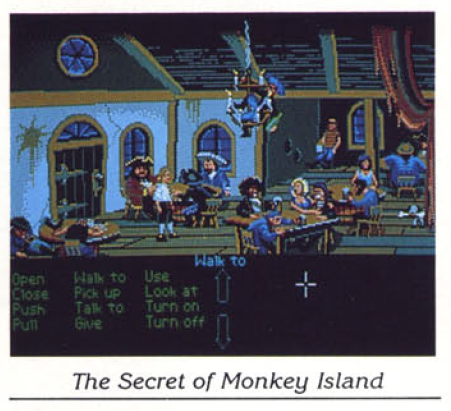
Hey, I know that guy!
I remember him better in a different outfit, though.
Perhaps something in flannel?
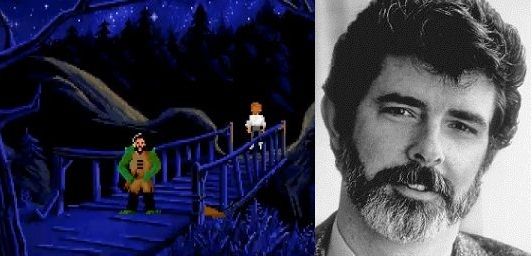
Why, it’s the troll guarding the bridge!
The man behind the man, as it were.
—
So, if Cob’s closeup wasn’t originally in Monkey Island 1, whose was?
“Here, boy!”

It’s Spiffy the Dog!
No doubt he came when he heard his master’s voice.
But who was the master… and who the apprentice?
—
I ask you now to refer to my earlier post, comparing the graphics of the PenUltimate in The DIG with the spellbook from King’s Quest VI.
Or not. Let’s go over it again, for safety’s sake.
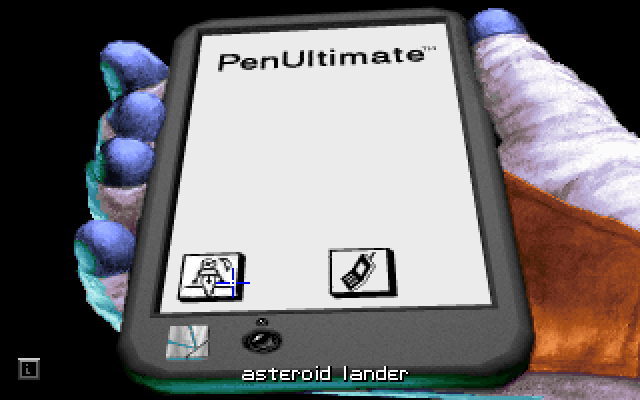
The PenUltimate from Sean Clark’s The DIG is tilted at an askew angle.

But this early render of the PenUltimate from Moriarty’s The DIG shows the original logo of Toshi Olema’s electronics company.
It’s the four plates of the asteroid from Sean Clark’s version… one game too early.
Now, will you step through the looking glass with me?
ROSELLA
“YES!!”
—King’s Quest IV
That’s what a true Hero does, you see.
In the world of King’s Quest, Alexander’s spellbook shows itself straight on to the reader.
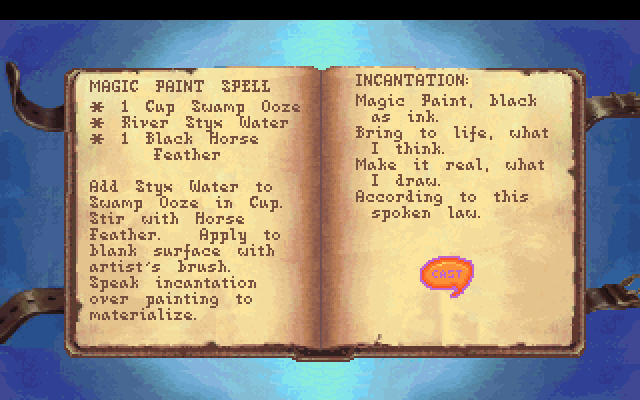
But outside the game itself—in a video on the KQ6 CD—the spellbook appears askew, like the PenUltimate in Sean Clark’s released The DIG.
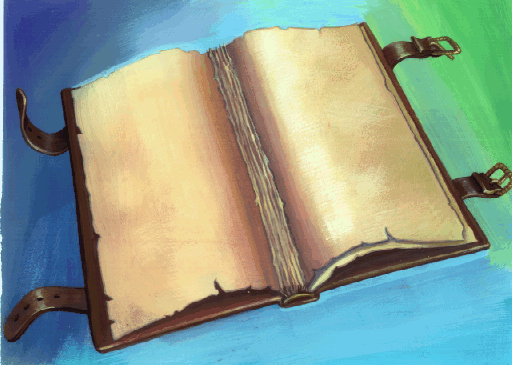
Not only that… most of the pages are ripped out of it!
Suddenly I’m getting flashbacks to MYST.
—
But the pages do exist… they were scattered in the Lands Above.
Our world.
I’ve been showing you some of them, even now… and writing others myself.
They’re the clues to a riddle, scattered throughout the whole history of adventure gaming.
And what does one do with clues?
One solves a mystery with them, logically enough.
“By the light of your eyes, my spirit soars!”
Quiet, you.
Logic provides a skeleton on which to build the framework of an idea.
But creating the idea itself requires something more.
Imagination.
Imagination, naturally enough, begets Hope.
Hope is something to be cherished, but also something to be set free… even as I’m doing now.
According to Greek mythology, Hope was what was lay caged inside Pandora’s Box.
That would make such a box the most valuable thing in the Universe.
Yet, in King’s Quest IV, you get the most points for locking Pandora’s Box in a mummy’s crypt… and sealing the crypt key in with the mummy.
But that mummy will never attack you—because Rosella has almost certainly already obtained the scarab she needs to survive its attack.
Only a debug mode lets her be killed by the mummy.
But… Rosella can die that way.
—
I’ve seen that mummy before!
Only, it had a different name, one drawn from English mythology… and it was in a different game.
Barrow
The splinter’s ghostly flicker does little to dispel the gloom of this
subterranean passage. Craggy walls bend away to the north and south.A barrow wight is lurking in the darkness close at hand.
A small hole is visible in the wall.
The barrow wight studies you with its red eye.
—TRINITY, by Brian Moriarty (1986)
Unless you have a lantern, and use it, the Barrow-wight in TRINITY will kill you.
It’s essentially a grue from Zork under another name.
What is a monster from a Brian Moriarty text adventure doing with a cameo appearance in KQ4?
Crashing the party?
Or storming the gates?
From the ashes a fire shall be woken, / A light from the shadows shall spring, / Renewed shall be blade that was broken, / The crownless again shall be king.
—
As I said, the land of Tamir is one in which Rosella forever locked Hope away in a crypt.
But Rosella reached Tamir through the Magic Mirror.
Not even Alexander did that.
What’s on the other side of the mirror?
This?

No, no, no!
That isn’t hope… that’s experience!
THIS is Hope:
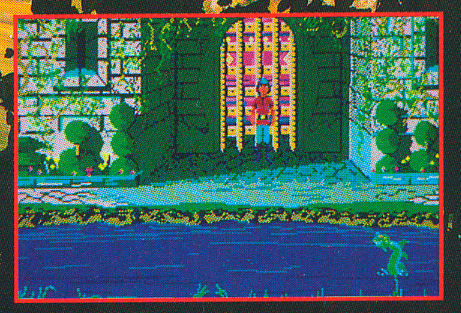
The above image is what appeared on the back of the original box of the King’s Quest I parser remake, which came out around the same time as KQ4.
It looks like false advertising.
Or maybe… it’s the triumph of hope over experience.
As Gottfried Wilhelm Leibniz said: “This is the best of all possible worlds.”
Leibniz, of course, invented calculus… or co-invented it, with Isaac Newton.
Remember the PenUltimate from The DIG?
It was based on a real-world computer product of the 1990s… the Apple Newton.
—
Interviews with ex-LucasArts employees which touch on The Dig often seem to be uncanny sources of newly discovered information about the project.
A 2003 interview with Bill Tiller in the PDF magazine The Inventory, for instance, was the first confirmation that the fourth character in Moriarty’s game was Toshi Olema, a male Japanese businessman… and not, as had been previously rumored, a “female Japanese physicist.”
Intriguingly, Tiller also offered the first-ever public mention of what, as far as I know, was then an entirely unknown cancelled LucasArts game: Indiana Jones and the Iron Phoenix.
Even after 12 years, I vividly remember my astonishment at first reading the title of a new Indiana Jones adventure game… albeit one which, Bill Tiller said, was not completed.
Here’s a screenshot of the puzzle which triggers the journey to Cocytus in Sean Clark’s The Dig.
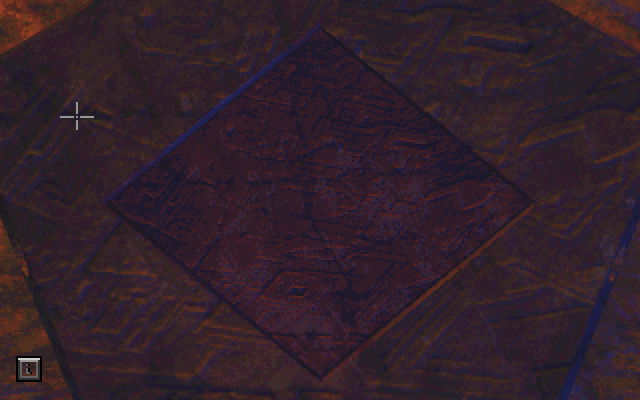
It involves the combination of four differently shaped metal plates.
When completed, they form a square… which proceeds to morph into an equilateral triangle.
But look at the same puzzle as it stood in Brian Moriarty’s version:
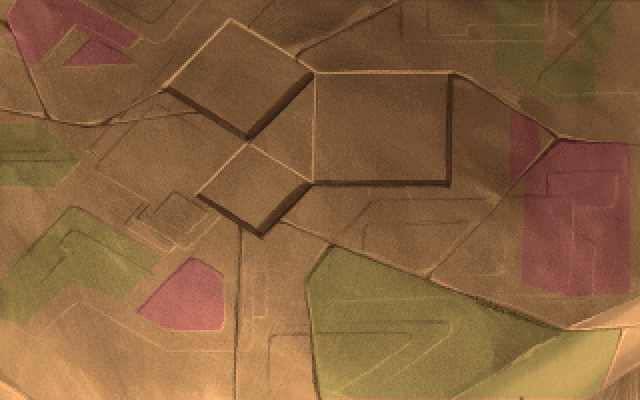
The plates here instead take the form of three metal squares, representing the Pythagorean theorem… which allows the use of mathematics to define the bounds of a right triangle.
How do you get from an equilateral triangle to a right triangle?
Divide the equilateral triangle in half.
Also… the version with four astronauts uses three metal plates to activate the starship. But the version with three astronauts uses four plates instead.
That’s one heck of a coincidence.
Or maybe it’s inverted symmetry… as if you passed The DIG itself through a Klein bottle, and got a different game on the other side.
And we know that Klein bottles, which create mirror images of three-dimensional matter, were in fact a part of the plotline in Brian Moriarty’s The DIG.
—
In another lecture, Pile of Dirt, with Trees, Moriarty discusses a now-demolished grotto garden from his childhood, built by a priest named Brother Sergius:
Sometimes, when I’m depressed or feeling sorry for myself, I forget the subtle legacy of Brother Sergius.
I start saying things like, I haven’t published a decent game under my own name since 1990.
Let my legacy be buried like the grotto of Brother Sergius.
Because the best way to mark something for a long time is with a huge pile of dirt.
—
Even Sean Clark’s The DIG has an important hidden treasure.
It’s the Cocytan Creator, buried within a crystal tomb.
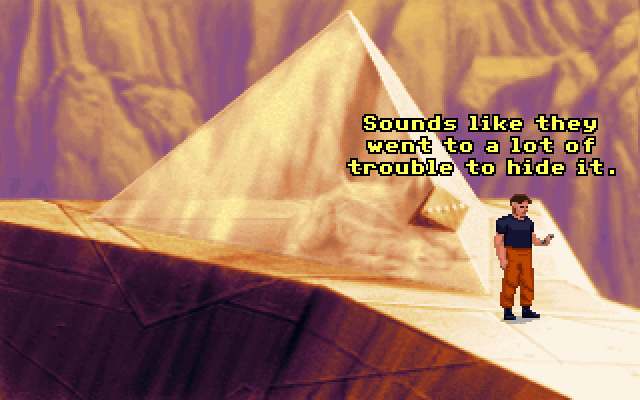
LOW
Maggie, I found something. It’s far below the tomb, past some pretty ugly guards. A dead alien sealed inside a crystal pyramid.MAGGIE
Sounds like they went to a lot of trouble to hide it.LOW
Must have been important to them. A king or something?MAGGIE
Or it terrified them. Remember, this is the land of the life crystals. Dead doesn’t necessarily mean DEAD dead. Maybe they were trying to keep it from being found and revived.LOW
But this is where the ghost wanted us to go. The key to the last door was the key that the first ghost showed us back in the ruined spaceship.MAGGIE
Still, you DON’T have a key to the pyramid, right? Besides, how do you know the ghost is our friend? Brink died by digging where the ghost pointed.LOW
I hate not having enough information.MAGGIE: I’m working as fast as I can to get this stuff translated. I’m so close I can taste it.
LOW: Fine, keep working. Call me if you think of anything helpful.
—The DIG, Sean Clark (1995)
The Creator’s tomb lies buried beneath a colossal statue which represents him in life.
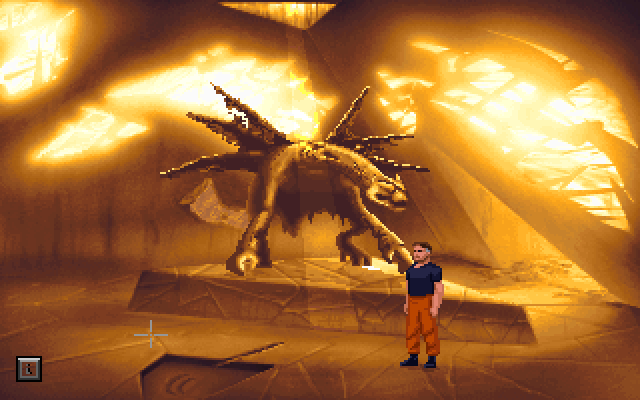
But when Low touches it, the statue evaporates into dust… opening the way to the being himself, who waits to be (grumpily) resurrected.
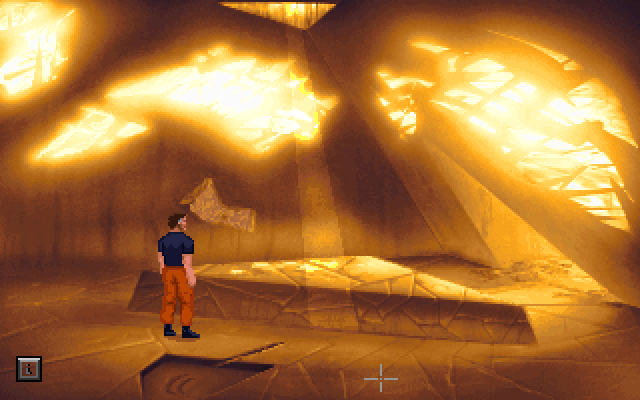
From the ashes a fire shall be woken, / A light from the shadows shall spring, / Renewed shall be blade that was broken, / The crownless again shall be king.
By the way… Boston Low DOES have a key to the pyramid.
In fact, he’s certain to have it by the time he finds the pyramid!
—
The strategy guide for The DIG claims that the Cocytan Creator was killed by the feedback forces when he first opened the gateway into Spacetime Six.
Just like Maggie Robbins.
But Alan Dean Foster’s novelization tells a different story.
In Foster’s book, the Creator was not killed by his own creation.
Rather, he chose to commit suicide.
—
And what does the crypt in Brian Moriarty’s The DIG look like?
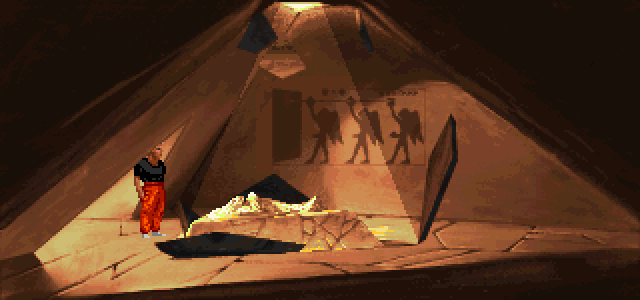
That looks familiar.
Let me think of it… Ah, yes!
Cemetery
Gloomy statues lie toppled among the tombstones, their broken limbs and heads
scattered like the carnage of a ghastly battle.A granite crypt lies across the ground. Beyond it rises the mound of an
ancient barrow. A black tunnel leads north, into the barrow.Sudden drops fall away on every side but south, where a flight of stone steps
descends the cliff.
I wonder if it’s possible for a decapitated, limbless, toppled statue by a crypt not to be gloomy.> EXAMINE CRYPT
The granite crypt must be hundreds of years old. It’s sealed shut with a heavy
lid.A name is engraved across the bottom of the crypt.
> READ NAME
The name on the crypt is WABEWALKER.> PRY THE LID WITH THE SPADE
You slide the end of the spade under the lid’s edge and lean on it with all
your strength.CRACK! You feel a puff of foul-smelling air as a section of the crypt’s lid
breaks away.> LOOK AT THE WABEWALKER
The solemn dignity of the crypt makes you suspect that the remains may be
those of some great missionary or explorer. The shrunken body is wrapped in a
gray burial shroud, and its wrinkled mouth is held shut with a bandage wrapped
around its head. A pair of boots, one red and one green, completes the ghastly
wardrobe.> GET THE BOOTS
The red boot: You take the red boot off the corpse.
The green boot: You take the green boot off the corpse.
And the clothes.> STRIP THE CORPSE
You remove the burial shroud from the corpse, revealing its decomposed body.> GET THE BANDAGE
As you pull the bandage off the corpse its mouth drops wide open.> LOOK IN THE MOUTH
The open mouth is blue and wrinkled. Inside it you can see a silver coin.> GET THE COIN
You take the silver coin out of the mouth.> LOOK AT THE COIN
The words NOT TRANSFERABLE are engraved on the silver coin.
—TRINITY, by Brian Moriarty
Later in the game, the protagonist uses the coin… which means that the corpse of the Wabewalker is their own mortal shell, doomed to die.
Boston Low evidently re-enacted this puzzle in The DIG, as the crypt in Moriarty’s game had the same flat lid as the one in TRINITY.
So… that version of Boston Low was also the Wabewalker?
This is getting positively Lynchean.
—
“I come not to praise Caesar, but to bury him.”
—William Shakespeare, Julius Caesar
“History repeats itself, first as tragedy, then as farce.”
—Karl Marx
“History is bunk. More or less.”
—Henry Ford
—
Brian Moriarty probably isn’t the only developer who tells lies… or, rather, spins yarns.
Lori Cole has said, often and publicly, that Roberta Williams prevented her from using the Genie of the Lamp, from the story of Aladdin, in Quest for Glory II, because it had already been used in King’s Quest II.
Instead, Lori used another famous Genie, the Genie of the Ring, for her own game.
But in the original Arabian Nights, both the Genie of the Lamp and the Genie of the Ring feature in the same tale, and work together to serve the same master… Aladdin himself.
And it’s not like the KQ2 genie was the last of its kind.
ALEXANDER
“Shamir Shamazel! Hold your spells! I am your master now. I order you to go back into your lamp.”ABDUL ALHAZRED
“WHAT? How did you get my lamp! You thief! You…you…you…. You’ve ruined me!”SHAMIR
“My lamp! Oh, thank Balhalla! I hated working for that loathsome creature! I already feel his nastiness leaving me! How I’ve longed for a master like you!”
—King’s Quest VI
Wait… why is an Arabian genie praying to the Norse heaven?
—
What kind of animal best personifies a Sierra game?
Probably a scorpion… like the one that bites Graham fatally in the desert in King’s Quest V, without warning, without giving him a chance to flee, simply for entering the wrong screen.
What kind of animal best personifies a LucasArts game?
Probably a frog.
After all, a frog machine is what powers the God Machine at the heart of Hal Barwood’s version of Atlantis.
In Indiana Jones and the Fate of Atlantis, Indy can get to the God Machine without rescuing Sophia.
But he knows that if he proceeds to complete the game without her, he’ll be condemning her to death.
And the game, through the voice of Indy himself, warns the player of this accordingly, and gives them a last chance to turn back.
—
“There will be no retreat.”
Aesop once told a story about a scorpion and a frog, who both wished to cross a river.
The frog offered to ferry the scorpion across, but he insisted that, in exchange, the scorpion must promise not to sting him in midstream.
As they crossed the river, the scorpion stung the frog, and they both began to drown.
The dying frog asked, Why?
The drowning scorpion replied, It’s my nature.
From the ashes a fire shall be woken, / A light from the shadows shall spring, / Renewed shall be blade that was broken, / The crownless again shall be king.
As the discussion is now back to adventure game developers, I’ll leave the thread in the Adventure forum for now.
the real question is, when will the discussion return to earth ![]()
—
“Nature is as nature does.”
—Proverb
“A lie?”
“A choice.”
—Star Trek VI: The Undiscovered Country
This is a classic version of the most famous problem of game theory… the Prisoner’s Dilemma.
In that scenario, two prisoners each are offered release from jail if they will agree to betray the other.
But if they both turn traitor, then they both suffer more than if the two endured together.
How do you convince a fellow prisoner not to condemn you?
Bribe? Cajole? Threaten? All of the above?
Or, perhaps… tell a story?
The world outside has not become less real because the prisoner cannot see it. In using escape in this way the critics have chosen the wrong word, and, what is more, they are confusing, not always by sincere error, the Escape of the Prisoner with the Flight of the Deserter.
—JRR Tolkien, On Fairy-Stories
What if the scorpion and frog could agree not to fight… except in jest?
Like, for instance, at a softball match?
And what stories did they amuse themselves with between serves, I wonder?
“Flesh may pass the portal
And seek its master Death.
Flesh may go where Death has trod
And challenge, like Scheherazade,
He Who Reigns Beneath the Sod,
To spare a mortal’s breath.”
“To challenge Death, lift up no human hand.
To fight with Death, take up no earthly sword.
The hand is here—the sword is yours.”
—
If you climb the Cliffs of Logic, what do you find?
The entrance to the Catacombs… a burial ground.
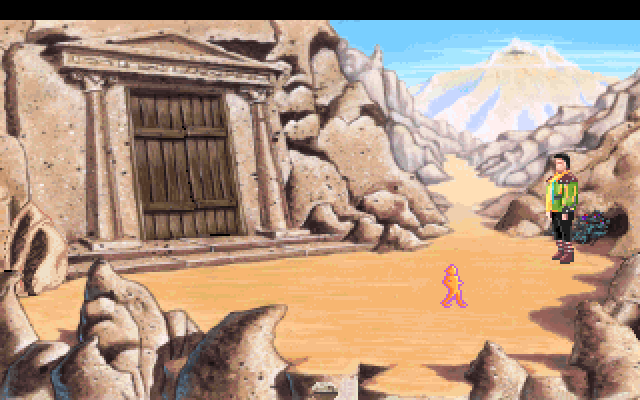
“Consider the common graveyard.
You Weavers would say that the Pattern is fragile here. Thin as gauze.”
—LOOM (Brian Moriarty)
As is a hero’s wont, Alexander goes to meet the Lord and Lady of the Winged Ones.
Aside from their wings, they are but ordinary humans, though greatly arrogant in character.

Lord Azure tells Alexander that his own daughter, Lady Celeste, is about to be sacrificed to the Minotaur, and that Alexander must save her, so Azure will have an excuse not to obey Vizier Alhazred’s orders to kill Alex.
If Alexander already has everything he needs to survive the Catacombs, he volunteers fearlessly:
“I am ready.”
“I am ready ... Mother. Let’s go.”
—LOOM talkie CD, Orson Scott Card
But if Alex doesn’t quite have what he needs yet, Azure will do something normally unthinkable in a Sierra game: he’ll give Alex leave to go out and gather more inventory items, and return when he feels he’s ready.
“Any parting message for the people of Earth?”
“We have exactly one chance. We’ve got to do it right. Let all your prayers be with us.”
—The DIG, Sean Clark
But if Alexander returns to the Winged Ones before he is fully ready, he is thrown into the Catacombs, having wasted his one last chance.
“Bobbin. It’s time!”
—LOOM, Brian Moriarty
—
But what happens if we go up a level… and try to climb the Cliffs of Logic outside the narrow confines of DOS or Windows 3.1 (or even DOSbox)?
We get this:
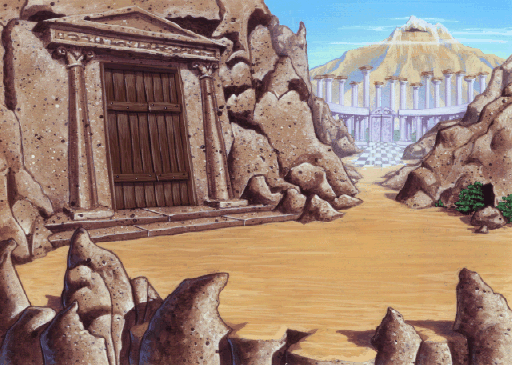
Where did that city come from?!
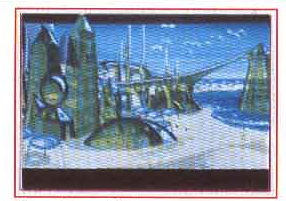
And that one—it’s an alternate version of Crystalgard!
The Wabe
A voice speaks into your ear.
LOOM: Shared!
And if we enter the city?
What do we see?
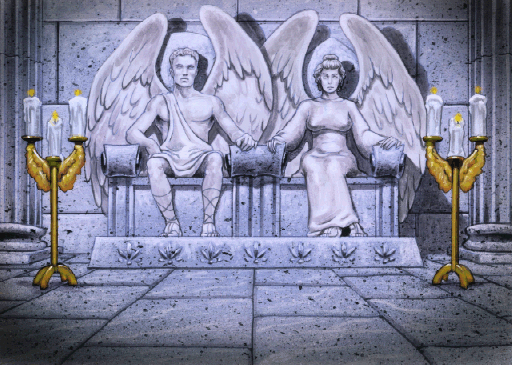
A pair of living statues!
Are these gods? Or men? Machines? Or all at once?
Well, at least, Azure and Aeriel are still their stuck-up selves.
But they’ve become stranger to look upon… and yet perhaps more beautiful.
The Wabe
A second voice speaks into your ear. It’s not as scary the second time.
FORGE: Shared!
In Sean Clark’s The DIG, the Cocytans were ordinary mortal beings, trapped on the other side of the sealed Eye.
By his persistence, Boston Low opened the Eye once more, and restored the Cocytans to the mortal-organized life they craved.
But in Brian Moriarty’s The DIG, they were already happy where they were… because they had made their choice with foreknowledge and acceptance of its consequences.
“To the well-organized mind, death is but the next great adventure.”
—Albus Dumbledore
But even Death can grow wearisome.
Moriarty’s Cocytans had the power to open the Eye all along… they just didn’t want to.
And now… they do.
THE FOLD: Shared!
From the ashes a fire shall be woken, / A light from the shadows shall spring, / Renewed shall be blade that was broken, / The crownless again shall be king.
“I am the doer who undoes, the creator who uncreates. And yet I would gladly be the destroyer who undestroys, the dangerous one who protects.”
—Cocytan Leader, The DIG
‘The title [Quest for Glory IV: Shadows of Darkness] is supposed to make the player think, “How can darkness cast a shadow? Shadows come from light.”’
—Corey Cole, Computer Gaming World issue 81 (April 1991)
A cold chill fills you, and you feel as if your blood was being sucked from your veins. Still, you continue.
“Oh, Great Dark One! Enter the world of light!”
You feel as if your feet were slowly and painfully dissolving into the floor as if by acid. Somehow, you continue the Essence Ritual.
“Oh, Shadows of Darkness, enter the land of the living!”
Your arms feel as if they were frozen, locked forever holding this paper. You continue to speak, because you have no other choice.
“Oh, Master of the Forever Night, return to your own body and live again!”
Your head aches, and it is getting incredibly difficult to concentrate. You can barely intone the last words of the ritual.
“Yah, yah Avoozl! We summon thee!”
—Quest for Glory IV: Shadows of Darkness
—
“Slowly and painfully dissolving into the floor as if by acid”?
I’ve seen that before.
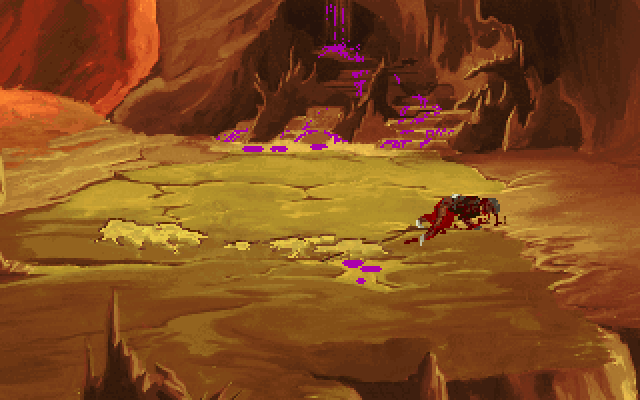
Poor Toshi Olema. As of yet, we’ve hardly known ye.
—
But, thanks to the round dial, AVOOZL can be re-spelled many different ways.
One of the most pertinent, perhaps, is LOOVAZ.
Two households, both alike in dignity,
In fair Verona, where we lay our scene,
From ancient grudge break to new mutiny,
Where civil blood makes civil hands unclean.
From forth the fatal loins of these two foes
A pair of star-cross’d lovers take their life;
Whose misadventured piteous overthrows
Do with their death bury their parents’ strife.
William Shakespeare, Romeo and Juliet, Prologue
“Ritter: Pro Patria”
—motto on the Ritter family dagger, Gabriel Knight series
“Dulce et decorum est pro patria mori.” (“It is gentle and fitting to die for one’s country.”)
—Horace (Roman Poet)
Grave men, near death, who see with blinding sight
Blind eyes could blaze like meteors and be gay,
Rage, rage against the dying of the light.And you, my father, there on the sad height,
Curse, bless, me now with your fierce tears, I pray.
Do not go gentle into that good night.
Rage, rage against the dying of the light.
—Dylan Thomas
The woods are lovely, dark and deep,
But I have promises to keep,
And miles to go before I sleep,
And miles to go before I sleep.
—Robert Frost, Stopping by Woods on a Snowy Evening
—
Fun fact: Romeo and Juliet was turned into an opera by Pioytr Ilich Tchaikovsky,who wrote the music for Swan Lake (reused in LOOM)... but also that of the ballet Sleeping Beauty (used in Disney’s 1959 film).
> get sword
Sword of the Paladin Piyotr: Taken!
> solve Kobayashi Maru
And how do you plan to do that?
From the ashes a fire shall be woken, / A light from the shadows shall spring, / Renewed shall be blade that was broken, / The crownless again shall be king.
This thread needs less alternate reality, a lot more actual reality.
It also needs to be stopped.
ATMachine, nice to see you back, but not like this. Please check your PMs.
You are here: Home → Forum Home → Gaming → Adventure → Thread




